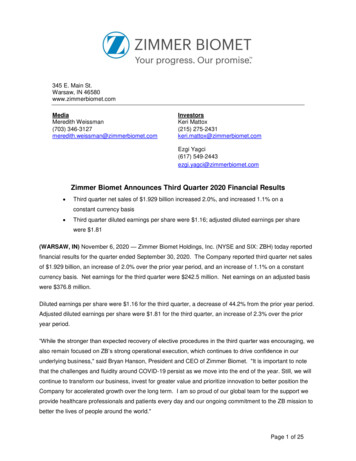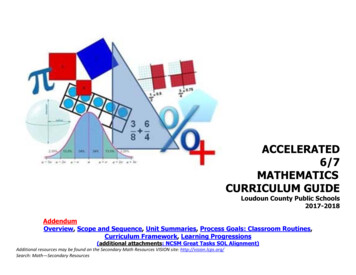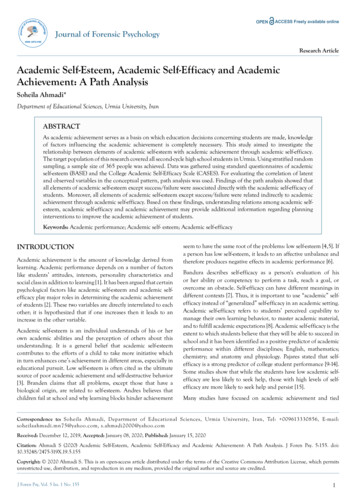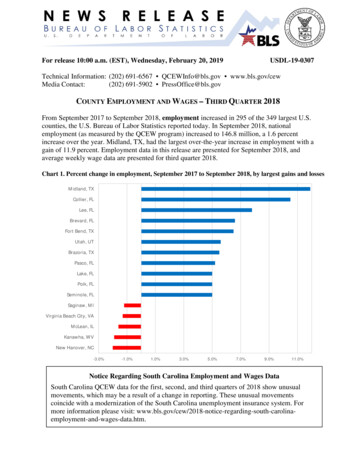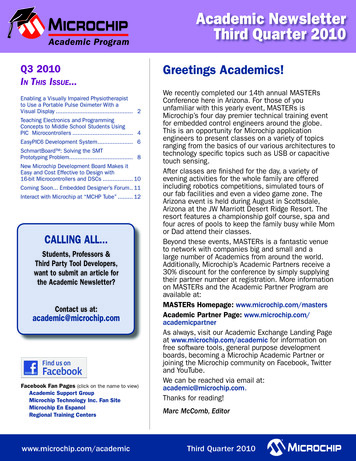
Transcription
Academic NewsletterThird Quarter 2010Q3 2010IN THIS ISSUE.Enabling a Visually Impaired Physiotherapistto Use a Portable Pulse Oximeter With aVisual Display . 2Teaching Electronics and ProgrammingConcepts to Middle School Students UsingPIC Microcontrollers . 4EasyPIC6 Development System . 6SchmartBoard : Solving the SMTPrototyping Problem. 8New Microchip Development Board Makes itEasy and Cost Effective to Design with16-bit Microcontrollers and DSCs . 10Coming Soon. Embedded Designer’s Forum. 11Interact with Microchip at “MCHP Tube” . 12CALLING ALL.Students, Professors &Third Party Tool Developers,want to submit an article forthe Academic Newsletter?Contact us at:academic@microchip.comFacebook Fan Pages (click on the name to view)Academic Support GroupMicrochip Technology Inc. Fan SiteMicrochip En EspanolRegional Training Centerswww.microchip.com/academicGreetings Academics!We recently completed our 14th annual MASTERsConference here in Arizona. For those of youunfamiliar with this yearly event, MASTERs isMicrochip’s four day premier technical training eventfor embedded control engineers around the globe.This is an opportunity for Microchip applicationengineers to present classes on a variety of topicsranging from the basics of our various architectures totechnology specific topics such as USB or capacitivetouch sensing.After classes are finished for the day, a variety ofevening activities for the whole family are offeredincluding robotics competitions, simulated tours ofour fab facilities and even a video game zone. TheArizona event is held during August in Scottsdale,Arizona at the JW Marriott Desert Ridge Resort. Theresort features a championship golf course, spa andfour acres of pools to keep the family busy while Momor Dad attend their classes.Beyond these events, MASTERs is a fantastic venueto network with companies big and small and alarge number of Academics from around the world.Additionally, Microchip’s Academic Partners receive a30% discount for the conference by simply supplyingtheir partner number at registration. More informationon MASTERs and the Academic Partner Program areavailable at:MASTERs Homepage: www.microchip.com/mastersAcademic Partner Page: www.microchip.com/academicpartnerAs always, visit our Academic Exchange Landing Pageat www.microchip.com/academic for information onfree software tools, general purpose developmentboards, becoming a Microchip Academic Partner orjoining the Microchip community on Facebook, Twitterand YouTube.We can be reached via email at:academic@microchip.com.Thanks for reading!Marc McComb, EditorThird Quarter 2010
Microchip Academic Partners NewsletterEnabling a Visually Impaired Physiotherapist toUse a Portable Pulse Oximeter With a Visual DisplayBy: Timur Yunusov, t.yunusov@theiet.org, University of Reading, UKIntroductionA pulse oximeter is an indispensable piece ofequipment for physiotherapists as it provides criticalinformation about a patient’s vital life signs such asoxygen saturation and heart rate. This data is relayedto the physiotherapist via a digital visual displaywhich is unfortunately inaccessible to users withvision-impairment.In the current situation a visually-impairedphysiotherapist has to constantly request theinformation from a specially trained personal assistant.The personal assistant’s role is to be an interface withthe clinical environment and assist with, for examplenavigation and reading and taking notes, but thislimits the physiotherapist’s independence. Requestinginformation would also introduce unwanted time delaysthat could be crucial in emergency situations.Therefore the aim is to enable a visually-impairedphysiotherapist to work independently with a standardportable pulse oximeter, through the development of anelectronic display reader.This design of such an electronic aid device is basedon a Microchip PIC24HJ64GP210 microcontroller andinvolves fiber optics for transferring light from thedisplay to the sensors and a SD card mass storagedevice with audio files containing pre-synthesisedspeech. Small size and good mobility – convenient andseamless to carry around. Low battery audio alarm – to inform the user that thecharge level in the battery is low and needs to bechanged. Vibrotactile feedback – to warn the user when oxygensaturation level is critically low. Normal and fast pace announcements – fast paceannouncements allows delivering the informationin shorter periods, therefore giving more frequentupdates of the values. Variable intervals for announcements – to make thedevice suitable for home and hospital use.Design and ImplementationDisplays on most pulse oximeters consist of threeseven-segment digits. Each digit can display numbers0-9 and it is sufficient to know the state of only 5segments to recognize a number displayed. Due tosimilarity of the displays, a power supply was used indevelopment of the proof-of-concept (Figure 1).SpecificationThe first stage involved working collaboratively with avisually impaired physiotherapist to derive the devicespecifications.Discussions with a visually impaired physiotherapistproduced a range of user specifications as follows: Auditory information output – speech is easy tounderstand and it carries less cognitive load,compared to tone or volume mapping. Miniature speaker – an ear piece could interferewith echolocation, where as a miniature speakerplaced around the neck or on the shoulder wouldbe sufficiently loud enough for the user to hear itwithout disturbing others. Physical interface with recognizable states – thisenables the user to easily recognize current modeand state of the device.2www.microchip.com/academicFigure 1: Seven segment display ofa power supply with optic fibers byan acrylic panel.The light emittedby an activesegment ispassed throughan optic fiber to aphoto sensor ona circuit board.A transparentacrylic patch isused to alignthe optic fibersexactly above thesegments whichallows otherpeople to see thedisplay as well.A similar patchdirects optic fibersdirectly onto thephoto sensors(Figure 2 and 3).Third Quarter 2010
Microchip Academic Partners NewsletterResults and Future WorkFigure 2: The optic fibers convey light from fivesegments of a seven-segment display to photo sensors.The light signals are processed and a value is read outthrough a speaker.The segments on the display are not continuouslyactive, but the display driver multiplexes each segmentat rate of 60 Hz resulting in a series of peaks in outputcurrent from each photo sensor. The current fromeach sensor is converted into 12-bit digital form using22 inputs of the Analog-to-Digital Converter module.The signal from each sensor is then filtered frombackground light with auto gain control and comparedto an experimentally selected threshold value todetermine whether an associated segment is active ornot.The pattern of active segments is converted to aninteger value using a simple look-up table and is usedto fetch the corresponding WAV file on the attached SDcard. The data on the card is accessed via Microchip’sMemory Disk Drive File System library[1], which providestools for convenient data management operations suchas finding and accessing a file.Storing pre-synthesised speech on an SD card allowsthe storage of dictionaries in different languages. Theaudio file is then played back through a pulse-widthmodulation driven speaker.The device also has a vibrotactile feedback which canwarn the user of a low battery or a critically low heartrate.The display reader is successfully working for a threedigit display, announcing numbers in English and infast or slow pace. Additionally, it warns the user if thebattery needs replacing and provides an opportunity tovary the frequency of the announcements.This conceptcan be furtherdeveloped toenable thedevice to readany segmenteddisplay. Thiswould requirecreating a customacrylic patchspecific to aparticular displayand channellingthe light fromthe segments toa connector forthe optic fibers.The connectorwould beFigure 3: Working proof-of-concept common acrosspatches, therebyreading display of a power supply.enabling a userto easily plug the reader into a range of devices. As aresult, not only can a visually impaired physiotherapistbenefit from using the device with a pulse oximeter,but consumers requiring assistance using domesticappliances with visual displays could also benefit.Possible applications include: microwaves, digital audiobroadcasting receivers or TV set top boxes.Reference1. Memory Disk Drive File System Library, ApplicationNote AN1045, Microchip Inc., Revision: 2/12/10.AcknowledgementsThis project was funded by the Undergraduate ResearchOpportunities Programme at the University of Reading.I would like to thank Dr. F. Hwang, Mr. P. Minchinton, Dr.A. Godfrey and Mr. D.Howlett for support.www.microchip.com/academic3
Microchip Academic Partners NewsletterTeaching Electronics and ProgrammingConcepts to Middle School StudentsUsing PIC MicrocontrollersA program of CABPES, the Colorado Association of Black Professional Engineers and Scientists.By Ron Fontenot and Ganesh BasawapatnaIntroductionThe Colorado Association of Black ProfessionalEngineers and Scientists, (CABPES, www.cabpes.org) isan organization that has been operating in Colorado forthe past 30 years. CABPES aim is to develop interestamong minority students in Mathematics, Engineeringand the Sciences so that they can enter creativecareers in these fields. Over 90% of high schoolgraduates who participate in CABPES go to college andproceed to earn degrees.CABPES operates multiple programs. It has a MathEnrichment Program, called MEP, where volunteers andinstructors provide Mathematics, and often Physicsand Chemistry assistance to elementary through highschool students three evenings a week. CABPES alsooperates a program called Junior Engineers, TomorrowsScientists or JETS, where students choose an area ofengineering to learn about by participating in projects inaddition to theoretical learning. It operates a programcalled Widening Our World (WOW) where the studentsteach senior citizens with no computer skills how tooperate computers and how to surf the web, createdocuments, send emails, etc. CABPES offers SATpreparation classes for students, and has many otherinteresting programs.4www.microchip.com/academicJETS has multiple areas of concentration includingAerospace, Mechanical Engineering, ElectricalEngineering, Architecture, Civil Engineering andConstruction, Programming and Software development,and others.The Microcontroller ClassOur area of concentration has been in ElectricalEngineering. We usually have around 15 to 17 studentsa year from 5th grade through high school seniors. Weteach principles of Electricity and Magnetism, Analogand Digital Circuits, RF and Microwave TransmissionPrinciples. The students attend 2 hours of class from6 to 8 pm every Tuesday during the school year. At theend of the year, the students build a project basedupon what they have learned and demonstrate it tothe community. Prior years’ projects have included anElectronic Maze, an Arcade Game, and Intelligent TrafficSignal, and others. The class is divided into threegroups, consisting of younger, middle school and olderstudents.For 2009-2010, we decided to take the middle schoolgroup of students and use PIC programming withMPASMTM Assembly Language to teach a number offundamental concepts – how a computer is designed,how it is programmed, and how it can be used tocontrol various useful things.We set up a laboratory consisting of 6 computers intowhich MPLAB IDE was downloaded. We decided touse the PIC16F88 family as it had an instruction setthat worked well for us to teach students the basicconcepts and to test them. With Microchip assistancewe obtained a number of demonstration boards at adiscounted educational price so each student had aboard with which he or she could program, test, andmove at their own pace.A JETS one-year program consists of 26 to 28 classes.The last 4 to 6 classes are devoted to defining andbuilding a Project that is interesting to the students anddemonstrates what they have learned.Third Quarter 2010
Microchip Academic Partners NewsletterThe first few classes were devoted to the fundamentals– what is a computer, what is a microcontroller, whatare its various key parts, how do they communicatewith each other, and what is an instruction set. Theylearned the relationship between assembly languageand binary instructions, and got the concept of howhigher level programming might be done.The students then created a series of short programsso they could learn how practical things are done, suchas turning on an LED or turning it off, counting, creatingsubroutines to handle repetitive tasks, and creatingdelays.The ProjectFor the project, we chose the PIC16F88 for theconvenience of its two 8-bit ports in a low pin-countpackage, and because its versatility would facilitate awide variety of projects as the students progress.Based on microcontroller concepts and a subset of thePIC assembly instructions that the students learnedearlier during the year, we embarked on a design projectto create colorful animated patterns on a circular arrayof RGB LEDs.We walked through simple flow charts as teamactivities to help the students understand the designprocess.We provided and reviewed with the students easyto-understand descriptions of a subset of the PICassembly instructions. Our approach emphasizedfirst learning the purpose and application of eachinstruction, and then learning the syntax.Next, we used program segment worksheets to guidestudents through the coding process. The studentsused their instruction set descriptions to look up theparticular instruction that would perform the operationdescribed for each step on a program segmentworksheet.Each student was provided with an 18-pin demo boardthat had been re-populated with a PIC16F88, and fittedwith an RGB LED circuit.The students used MPLAB IDE to edit, assemble,and debug their code segments, and then used thePICkit 2 to program the PIC16F88.Initially, the students wrote code segments to changethe color of a single RGB LED by writing the appropriatebit patterns to an output port of the PIC16F88. Thestudents also wrote code segments for counting, delayloops, and pushbutton detection. Later, each studentassembled and soldered their own circular RGB displayon a custom PWB.Students also learned to store bit patterns in theon-chip EEPROM which could be read out to a port tocreate a variety of patterns on the RGB LED display. Bycombining this segment with their loop counting anddelay code segments, they created a short program togenerate rotating squares, triangles, a spinner patternand a “chaser” on the RGB display board.At the conclusion of this class, the students displayedtheir projects along with those of other JETS studentsto parents, friends and educators at the CABPESAnnual Awards Banquet in May.Even though JETS students have been in school all day,they arrive in the evening highly motivated and excitedabout what they are learning in the microcontrollerclass. We believe that the JETS microcontroller classbenefits our middle school students in many ways,including the following: Increasing their confidence in applying technologythat is entirely new to them. Helping them gain insight into how computers work. Providing an early introduction to basic programmingconcepts. Helping them to take on new challenges andsucceed.AcknowledgementWe at CABPES would like to thank the staff atMicrochip, in particular Marc McComb, for proving usparts and useful guidance. Based upon this experienceit is our intent to expand this class in the future.www.microchip.com/academic5
Microchip Academic Partners NewsletterEasyPIC6 Development SystemThe easiest way to create your own PIC MCU-based electronic device.Mikroelektronika offers a broad line of PICmicrocontroller development tools and related productsthat are reasonably priced for engineers, students andbeginners. This article presents EasyPIC6, one of theflagship development kits from Mikroelektronika.EasyPIC6 OverviewEasyPIC6 is a full-featureddevelopment system for PICmicrocontroller applicationsdevelopment and test. Thistool provides a complete,development platform supportingPIC (P10, P12, P16 and P18)devices. With built-in electroniccircuits including: USB 2.0 programmer with mikroICDsupport, touch panel controller, keypad, port expander,serial COG display, DS1820 support and much more,the EasyPIC6 Board has many practical features forusers to develop various embedded applications usingthe most popular components in electronic products.On-Board USB 2.0 Programmer withIn-Circuit DebuggerEasyPIC6 has a built in PIC MCU programmer thateasily connects to a PC via USB cable. The programmercircuitry features the ability to fully switch the PGD,PGC and MCLR pins, so they can still be utilized in yourproject. This system lets you have full use of all PICMCU pins at all times with the programmer only takingcontrol of them during the fully automatic programmingitself. The programmer also has a built-in ICD hardwaredebugger that runs under the same USB lead andis standard in all MikroElektronika compilers for PICMCUs.This programmer is easy to use for beginners.Simply write source code on a PC using one ofMikroelektronika’s compilers (mikroC, mikroBasic ormikroPascal PRO), then program the PIC MCU usingEasyPIC6 (this takes about 10 seconds), and yourproject will start working. This allows very fast projectbuilding and modifying. Note: You can use any compileror assembler that produces standard Intel HEX format,you can then use the free PICFlash Windows softwareto load the .HEX file into the EasyPIC6.Built-In Electronic PeripheralsAt the heart of the EasyPIC6 board is a PIC16F887MCU in a removable 40-pin DIP socket. Besides the6www.microchip.com/academicDIP40 socket, DIP20, DIP18, DIP14 and DIP8 socketsare available on the board to handle lower pin countPIC MCUs. The MCU is totally accessible with all of itsports bonded not only to connectors and DIP switcharrays but also to LEDs for easy visualization of logicstates as your program is running. Input to the digitalports is easy to simulate by means of 36 pushbuttonslabeled with port pin names. Inputs can be alsosimulated via keypad 4x4 and menu keypad. The analogmeasurement can be done with PIC MCU pins RA0-RA4on the pin header and a potentiometer on the board tosimulate discrete analog levels between 0 and 5V. Forhigher level connectivity, the board has RS232, PS/2,USB and a external ICD connector.Various Displays SupportedFor visual messaging purposes, the board contains aserial COG display that is capable of displaying textmessages. In addition, the board supports EasyPIC6development system standard 2x16 LCD characterdisplay. For advanced visual messages, Graphic LCD128x64 can be placed on-board. Graphic LCD combinedwith TouchPanel can also be connected on-board andused as an input device.Comprehensive DocumentationFull color documentation clearly explains the EasyPIC6.Additional manuals and manuals on the PICFlashprogrammer section, the debugger,and a completeschematic diagram are included. These comprehensiveand easy to use manuals include demonstrations andexamples that can be put in the context of real lifeprojects.Intuitive Working EnviromentEasyPIC6 provides an intuitive working environment,a large number of peripherals with lots of usefulexamples, additional tools that boost productivity andfacilitate development, fast and reliable support andresourceful user manuals. The kit and software toolssupplied reduce hardware difficulties allowing usersto concentrate on software and understanding andoptimizing the PIC MCU code.Accessory BoardsAccessory boards allows students or engineers toeasily exercise and explore the capabilities of thePIC microcontrollers with peripheral devices such as:ADC, DAC, CAN, Ethernet, IrDA, MP3, RS485 and manymore. The use of the boards is simple, just connectThird Quarter 2010
Microchip Academic Partners Newsletteran accessory board, load an example to the PICmicrocontroller and you are set for device development.Included CompilersFully-functional demo versions of mikroC PRO forPIC , mikroBasic PRO for PIC and mikroPascal PROfor PIC compilers are shipped with the board. Demoversion, HEX output is limited to 2k of program words.These compilers come with examples that show howto easily connect the PIC microcontroller with otherperipheral components or devices when developingyour prototype device. Each example contains detaileddescription and comments of the program. Registrationkeys for these compilers can be obtained online fromMikroElektronika.Wide Range of PIC Microcontrollers SupportedThe EASYPIC6 development system supports morethan 120 PIC microcontrollers. Newly released PICmicrocontrollers will be supported with regularlyupdated versions of PICFlash software.mikroElektronika manufactures high-qualitydevelopment tools for microcontrollers. In addition, theydevelop sophisticated, comprehensive compilers andtools for PIC MCU users who want to get a quick start.mikroElektronika also distributes books and articles,many of which are available for browsing and download,absolutely free of charge.For more information contact:mikroElektronikaVišegradska 1A11000 BelgradeAddress Code: 111701EuropePhone: 381 11 30 66 377Email: office@mikroe.comVisit our web site at: http://www.mikroe.comwww.microchip.com/academic7
Microchip Academic Partners NewsletterSchmartBoard :Solving the SMT Prototyping ProblemBy: Neal Greenberg, VP Sales & Marketing for SchmartBoardSchmartBoard was incorporated in 2005 with the goalto make prototype boards useful again. We saw thatcompanies were spending too much time and moneyperfecting prototypes and knew that a market existedfor a better solution. The SchmartBoard founderswanted to create a system that allowed companiesto cleanly, quickly and inexpensively create workingprototype circuits using today’s SMT componenttechnology. The idea was not to replace the customPCB prototype step but to assure that prototype boardswould not have to be produced numerous times.This would reduce the time-to-market and overalldevelopment costs much like wire wrapping did thesame a generation ago.In addition to the problems in industry, SchmartBoardsaw SMT creating a problem in electronics educationand also the hobbyist market. For the student, partsare less prevalent in a DIP package. If one wants towork with a gyro component for example, DIP is notan option. If a student is to graduate with the bestengineering education, they certainly do not want to belimited by the inability to solder today’s most currenttechnology. The same issues impede hobbyists inelectronics, robotics, ham radio and other niches.The first SchmartBoard products were genericprototyping boards with one main innovation calledSchmartBridge . We made our boards 5 x 5 cm(2 x 2 in) in size. These boards supported numerouspitches of the most popular components for SO, QFP,PLCC packages as well as through-hole components.We then put notches on all four sides that connectedto a plastic piece called the SchmartBridge. TheSchmartBridge allowed you to connect the boardstogether. The reason for this is to first reduce the realestate, and second to make testing and debuggingeasier. We felt that users should be able to choosewhat is on their real estate. By building it in smallblocks, they could do that. In addition, by allowingusers to build a block at a time and then connectingthem together using the SchmartBridge, testing anddebugging can be performed on the individual circuitblocks instead of the entire prototyping board as intraditional options.We also started producing SchmartModules.SchmartModules are common populated circuits suchas RS232 and power regulators that also can connect8www.microchip.com/academicto a circuit using SchmartBridges to make prototypingquicker and easier.We had users who were happier than before, butsurveys confirmed that we had a lot of work to do.People loved the boards and the modules, but manyjust did not have the skills to hand-solder surfacemount components, especially when pitches are .5 or.4 mm. Two problems impede people’s ability to handsolder tiny surface mount components. The first is theneed to place and hold the components correctly inplace on the pad surface. The second is hand solderingin such small confined areas without creating shortcircuits.TheSchmartBoard ezemploys a raisedsolder mask thatforms canalsaround pre-tinnedtraces. Thisholds surfacemount integratedcircuits in placeand permits easysoldering.The SolutionIn September 2005 we released SchmartBoard ez .SchmartBoard ez’s patented technology solves theseissues in the following way. Unlike all other circuitboards, the solder mask is higher than the pads, notlower. This creates canals on the surface of the board.The solder mask makes the walls of the canal, andthe floor of the canal is the pad surface. The legs of asurface mount IC fit into these canals, thus, allowingeasy hand placement of the chip legs onto the pads.A fine-tippedsoldering ironmelts the thinlayer of solderinside eachSchmartBoard ezcanal. The raisedsolder maskprevents shortcircuits betweentraces.Third Quarter 2010
Microchip Academic Partners NewsletterThe IC is soldered in place using a soldering iron witha finely pointed tip. No external solder is required.Instead, the soldering iron heats the solder on the padsin each of the canals and pushes the molten solderfrom the end of the canal until the iron touches thechip’s leg. The solder stays in the canal, thus, assuringthat no shorts are created. This is repeated for eachcanal that has a leg to be soldered. A quick overview ofthis technology can be seen in a video at: http://www.schmartboard.com/index.asp?page schmartboardmovie.Bringing SchmartBoard ez to MCUsIn 2009 we realized that because people could handsolder ICs using our technology, we could produceapplication specific boards that would allow users achoice of which component they wanted to use. Wedecided that microcontrollers were the way to go, andthat Microchip’s 8-bit PIC MCU was the best candidateto make a very flexible and inexpensive developmentboard.We released the SchmartBoard Development Board Afor the 8-bit PIC microcontroller in 2009. The 2” x 2.5”board has an on-board 5V power regulator and resetbutton. It also supports optional external clock options,ICSP and RJ11 interfaces for programming. 8-bit PICMCUs in 8, 14, 18, 20 and 28-pin SOIC packages areall supported by this single board, 116 in all. The usersimply hand solders a PIC MCU using SchmartBoard’s“EZ” solder technology, adds a row of headers(included) and then configures jumpers for the type ofPIC MCU that was soldered onto the board.This PIC MCU development boardis the most flexible option on themarket for PIC device compatibility.At a price of 15, this inexpensivesolution offers frequent PIC MCUusers the opportunity to keep anumber of development boards on hand knowing theywill work with any 8-bit PIC MCU SOIC chip they usein the future. For a distributor this is a real inventorysolution. A distributor can now stock one part tosupport 115 PIC MCUs. Today a distributor must stockmany different boards to support the many 8-bit PICMCU options. The board is offered today domesticallythrough Microchip Direct, Mouser Electronics, JamecoElectronics, Frys Electronics and at SchmartBoard’sweb site.SchmartBoard plans to follow up this product withan 8-bit PIC MCU board for QFP packages as well asboards for 16-bit PIC MCUs.A video demonstrating the use of the board canbe seen at: http://www.schmartboard.com/index.asp?page pick your picSchmartBoard’s 2010 MCU Challenge is really three contests in one. Prizes arebeing awarded for circuits based on Microchip PIC MCUs, Texas Instruments devicesand Parallax Propeller MCUs.For the Microchip portion of the challenge, first prize wins an Apple iPad ; secondprize is a Cue Radio Model r1; third prize is an MPLAB ICD 3 In-Circuit Debugger;one honorable mention wins a MPLAB Starter Kit for PIC18F MCU and four otherhonorable mentions will win a 50 Coupon at Jameco Electronics or Robot Shop.Hurry! The entry deadline is November 30th, 2010. Rules and more information canbe found at: www.schmartboard.com.www.microchip.com/academic9
Microchip Academic Partners NewsletterNew Microchip Development Board Makes itEasy and Cost Effective to Design with16-bit Microcontrollers and DSCsMicrostick for dsPIC33F & PIC24H ProvidesSmall Size and Integrated Programmer/DebuggerMicrochip has introducedthe Microstick fordsPIC33F and PIC24Hdevelopment board,which provides acomplete, low-costsolution for designingwith Microchip’s 16-bitPIC24H microcontrollers and dsPIC33F Digital SignalControllers (DSCs), in a compact 20x76 mm footprint.At a low cost the Microstick offers an integratedUSB programmer/debugger, which shortens learningcurves. For maximum flexibility, the Microstick can beused stand-alone or plugged into a prototyping board.Additionally, educators are eligible for a 25% discount.Many engineers, educators, students and hobbyistsneed a low-cost solution for working with and debuggingcode on 16-bit microcontrollers and DSCs. In additionto its other benefits, the Microstick is populated witha socketed microcontroller that can be easily swappedout. The Microstick works with the PIC24HJ64GP502,which is the highest performance 16-bit MCU in theindustry, and the dsPIC33FJ64MC802 DSC, whichseamlessly blends DSP and MCU resources into asingle architecture. Software support includes the samefree MPLAB Integrated Development Environment (IDE)and software libraries that work with all of Microchip’s8/16/32-bit PIC microcontrollers and DSCs.
Conference here in Arizona. For those of you unfamiliar with this yearly event, MASTERs is Microchip's four day premier technical training event for embedded control engineers around the globe. This is an opportunity for Microchip application engineers to present classes on a variety of topics







